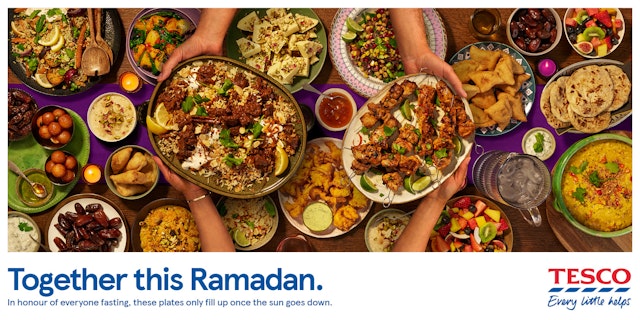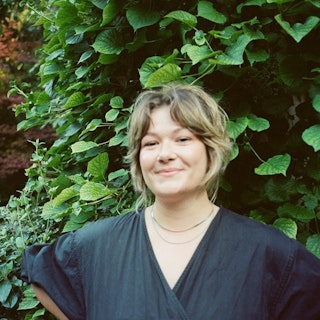Why every little detail mattered for Tesco’s first major Ramadan campaign
BBH executive creative director Helen Rhodes and Asad Dhunna, founder of inclusion consultancy The Unmistakables, talk us through the considerations that went into accurately reflecting the Iftar experience for Tesco’s ‘Together this Ramadan’ campaign.
Throughout April, Tesco will be marking Ramadan with an out-of-home (OOH) campaign centred on Iftar, the evening meal that signals the end of daily fasting.
Despite over 3 million of Tesco’s customers celebrating Ramadan every year, this is the first time the supermarket has highlighted the month in such a way and is part of a commitment to inclusivity in its marketing.
Created in partnership with BBH, the digital billboards show empty plates filling up with food as the sun sets. The slogan reads ‘Together this Ramadan‘, while below is the line: ‘In honor of everyone fasting, these plates only fill up as the sun goes down‘.
”We really wanted to make something that spoke to the community,” says Helen Rhodes, executive creative director at BBH.
She says that, early on in development of the campaign, the creative team considered whether this would be an exciting opportunity to educate the wider public on the traditions of Ramadan. However, through working with inclusion consultancy The Unmistakables, the team learned of the importance of targeting the Muslim community in order to make them feel represented.
Asad Dhunna, who is the founder and chief executive of The Unmistakables, explains: “Our stereotype study revealed that, within the broader media landscape, 67% of Muslim people feel they are portrayed in a negative light in the media, so it is our job to help brands stand behind the community and stave off any negative criticisms.”
In order to represent the Muslim community as authentically as possible, BBH recruited Khalil Musa, a photographer and a practicing Muslim, as well as food consultant Dina Macki, whose food is influenced by her Middle Eastern background. Some of the cast was selected from Muslim colleagues within the Race and Ethnicity Network at Tesco, who were also consulted throughout the campaign development.
Having Muslim representation across the team was vital, says Dhunna: “You wouldn’t ask someone to create a Christmas setting if they’d never celebrated Christmas. And there’s also so many nuances within the Muslim faith, from different sects to country of origin. People convert or have different stances depending on their level of belief or tradition, so there is no one size fits all.”
Dhunna says that, when it came to creating the images, the team really considered “what a traditional Iftar table would look like in each of our own homes”.
Attention to detail was, therefore, crucial in order to accurately reflect the experience of Iftar. As Rhodes explains: “We consulted on everything from the table runners, to the colors we used, to the patterns on plates.”

Even the presence of nail varnish was up for discussion, adds Dhunna. “You might think that nail varnish would be a welcome but insignificant detail – you know, to add a nice pop of color. But in the Islamic faith, women don’t tend to wear nail varnish, particularly during Ramadan. When you are washing your hands five times a day for prayer, it’s seen to act as a barrier to that.”
This attention to detail also extended to the media buying activity for the campaign, which, Rhodes says, “was a tough criteria”.
“Of course we wanted to be in areas with a large Muslim community [the billboards will be seen in places such as Brent in London, Birmingham and Bradford], but we also needed to block out a specific time and duration for the billboards as we didn’t want any other ads playing in between – especially anything that wouldn’t be in keeping with the observation of Ramadan, like alcohol for example.”
The billboards also needed to be facing eastwards in order that the sun sets behind them and the creative fades in as the sun goes down to accentuate the break of fast coinciding with sunset.
Dhunna says that, after many years working in the creative industries, it’s heartening to see agencies like BBH “really wanting to take this seriously and do something about it”.
”It’s brilliant,” he says.

